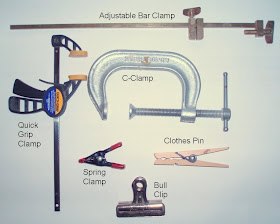Ask any woodworker what he or she thinks they could always use more of, and they'll say, "Clamps." Nothing is more frustrating than to be working on a project and to run out of the size or kind of clamp you need!
Regardless of how many power tools you may have, you still need clamps. All of the clamps I show at the left are the ones I most often use; although this is not the extent of my clamp collection. I have LOTS of all of these and in varying sizes. (Clothes pins excepted - I know of only one size for them!)
As humble as they may be, clothes pins make a wonderful mini clamp. I used them just last night to hold down some matte board I was gluing to the framework of a roombox wall. I used both the spring clamp (shown above) and the clothes pins, and realized the clothes pins did a better job. The spring clamps gripped too hard and actually put a dent in the matte board. The clothes pins gave enough pressure to hold the object firmly, but not too firmly to cause any damage to the items being glued.
I also like the adjustable bar clamp shown at the top of the page. I can release the tension of the screws and move the sliding clamp up until it touches the project. Then I tighten that part. Next, I turn the top screw until the gap between the parts closes. Once I see no gap, I stop tightening.
Karin F. asked me to write something about corner clamps. I have one, Karin. Appropriately, it's buried in the corner of my workshop. I should just toss it out, because I never use it. When the miniature club began to work on building our room boxes, I made a corner gluing jig for each club member. I've made a few slight alterations to that concept and at the right, you can see how I took a couple of small pieces of MDF board and glued them up into a precise right angle. I put some screws in from the bottom side to help hold these pieces in place so that they don't break loose from the base. With this kind of set-up, you now have "walls" against which you can clamp your boards, and a base against which you can set a third piece of wood and hold them all together. Depending on how big a project you're doing, something as small as what I have shown here (about 8" x 4") is all the bigger you'd generally need.
I do have a metal gluing jig with very aggressive magnets and precisely bent corners. I have used that on many occasions to glue up square corners. (With miniatures, you just don't need very heavy equipment.) It worked very effectively for me.
I also found another very helpful "gluing jig" which was not intended for that purpose at all! The item I'm referring to is a ruler used for safe matte cutting. It's marked item #2 in my blog about rulers:
http://tallminiguy.blogspot.com/2009/07/measures-for-success.html. This ruler has a vertical bar down the middle of it, that projects upward at a 90 degree angle and stands up about an inch above the ruler body.
I used it tonight to glue up some additional wood onto some crown molding I had purchased. I felt the commercial crown molding was too small - barely over a half-inch tall, meaning my crown molding would be about 6" tall at the most. With a 12' ceiling, a 6" crown molding (in scale) seemed skimpy. So, I clamped this ruler lengthwise on my workbench using a C-clamp to stretch over to the back side of the ruler, leaving the front edge "open" so that I could push against that to glue up my crown molding. It worked like a charm, and now my crown molding is about 10" in depth (in scale). Much better!


No comments:
Post a Comment